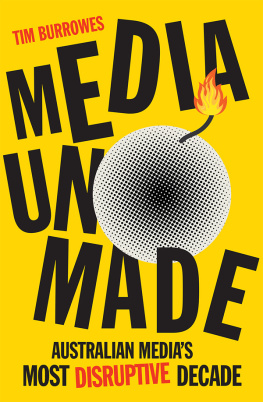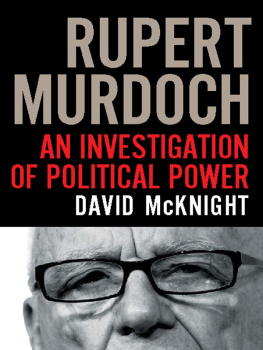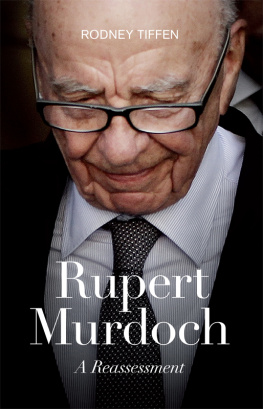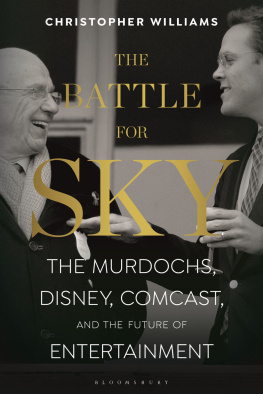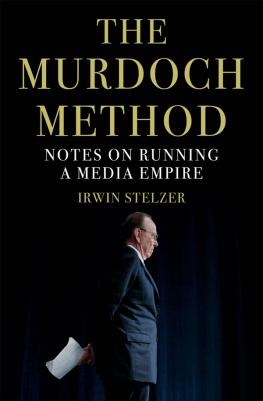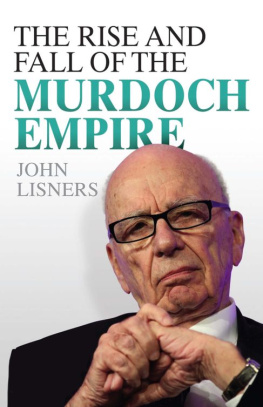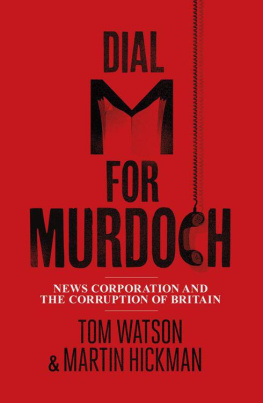Acknowledgements
This book would not have happened without the encouragement and enthusiasm of MUP CEO, Louise Adler. Got issues of self-doubt? Talk to her; shell fix that.
Man Bites Murdoch started as a very different enterprise. Just weeks after my unexpected sacking from the Herald Sun in November 2008, Louise approached me to consider writing a book about the troubled state of the Australian newspaper industry or, at least, an aspect of it.
This followed her discussions with another former editor of The Age , MUP chairman, Alan Kohler. I am indebted to both of them for coaxing me out of my post-dismissal trauma to get working on the project.
Along the way, the book changed complexion, aided by the extraordinary events that culminated in a six-day trial in the Victorian Supreme Court in AprilMay 2010. Suddenly I was writing a very personal story about the industry that had sustained me for almost four decades and a court case that threatened to define me.
I have others to thank at MUP too: executive publisher Foong Ling Kong was a terrific sounding-board throughout. Thanks also to Jacqui Gray, Terri King, Cinzia Cavallaro and Ross Wallis. Freelance editor Susan Keogh made some crucial last-minute saves and suggestions. I am particularly indebted to Susan for removing the curse of the dangling modifier, which had haunted me for most of my career.
I will also forever be indebted to the legal team who not only prosecuted the case against News so skilfully, but also assisted me in the writing of the book, particularly the final chapters devoted to the trial. Chief here were Tony Macken, principal of A.J. Macken & Co, and senior counsel Norman OBryan. Tonys son Dominic was also a constant source of strength, knowledge and wisdom throughout the case and the writing. Who would have thought an Essendon supporter could become so fond of three ardent Collingwood fans?
There are a great many journalists and editors to thank too, although some have asked to remain anonymous. Inevitably a book such as this focuses on the detractors and foes I encountered along the way. But there have been many more benefactors and allieshow else would I have attained some of the most senior positions in Australian journalism? I am indebted to them all, particularly those who helped with their insights and memories. As former VFL coach Tommy Hafey might have said when pressed for names: They know who they are.
That said, I would like to publicly thank my long-time friend and colleague Eric Beecher for his early advice and encouragement; author Les Carlyon and another former Herald colleague Bruce Baskett for their recollections and insights into the Murdoch takeover of HWT; my good friend Gabrielle Trainor for her wise counsel throughout; author and editor Roger Franklin, who helped with some of the more descriptive passages in the book; former Syme managing director, Greg Taylor, for clarifying aspects of the banks move on Fairfax; the aptly named Larry Writer for his help on the Who Weekly chapter; and the extravagantly monikered Cutler Durkee III who, along with fellow People magazine staffer Rob Howe, assisted with the chapters on my time in New York.
Katie Flack and other staff of the newspaper reading room at the State Library o f Victoria also deserve thanks. I spent many hours there poring over microfilm, refreshing my memory about specific newspaper editions and stories. It was an invaluable resource, shoring up the diary notes, documents, transcripts and recollections that are the basis of the book.
I also referred to Max Hastings autobiography, Editor (Macmillan, 2002), to bolster my memory of a conversation with him over the origins of the Tourang syndicates bid for Fairfax, and to William Shawcross 1992 biography of the News proprietor ( Murdoch , published in Australia by Random House) when recalling a gathering of News executives at Aspen, Colorado, in 1987.
I want to acknowledge the support of my late mother, who passed away just six months before we triumphed over News, and the assistance of my brother Ross on life in Broadmeadows and my sister Janice on the Footscray years. Dr Loris Figgins was extremely patient in answering my queries about my two years in the Austin Hospital. She was a lifesaver in more ways than one.
Finally, I wish to thank my wife, Janne Apelgren, and our children, Susannah and Scott, not only for their forebearance over the past 22 months, but their unconditional love and support. My son deserves special mention for coming up with the title of the book; never has a drive to Saturday morning sport been so productive. They are the real heroes of this book, particularly Janne, who has supported me throughout all my endeavours and remained steadfast in the face of some appalling intimidation as the court case loomed. She gave me the strength to stand tall.
Bruce Guthrie, Melbourne, August 2010
1
Rupert comes to town
T he executive offices of the Herald & Weekly Times, publishers of Australias biggest selling daily newspaper, are lined with gold. Or, at least, they appear to be. In some ways this is apt: the Victorian-based HWT makes more than $100 million profit in a good year, with Melbournes Herald Sun contributing the great bulk of it. And there have been many good years.
Huge doors, as wide as they are tall and painted a glistening gold, greet you on the thirteenth floor of the HWT Tower, the companys home on Melbournes Southbank. Its not the sort of decor you expect from the peoples paper, bought by more than 500 000 a day and read by almost three times that many across Victoria. The Herald Sun is an Australian publishing phenomenon that dwarfs Sydneys Daily Telegraph , Brisbanes Courier-Mail , Adelaides Advertiser or any other local daily you care to name. If it was published in the United States, it would outsell all but a handful of American papers, despite drawing on a population of only just over 5 million.
Its not just the golden doors that strike you about its executive row either. Compared to the crowded hubbub immediately below on the main editorial floor of the Herald Sun , the executive offices are sparsely populated and eerily quiet. You might occasionally hear a raised voice at the Thursday morning management meeting in the main conference room or from a lunchno alcohol allowedthrown for members of the business or political elite in the dining room. For the most part though, things happen here in a whisper and at a dignified pace.
The eastern and northern sides of the executive floor are home to HWTs most powerful players, the managing director and the chair of HWT respectively. Between their offices is another, right on the north-east corner of the thirteenth floor. It is the best office in the whole place but, save for the occasional squatting executive waiting on a more permanent home, it is vacant for most of the year, in a constant state of readiness in case The Great Man should drop in. It is Rupert Murdochs office and it so happens that on this day, 27 October 2008, he is in town. Consequently, everyone is on edge.


